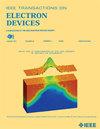Boosting Performance of AlGaN-Based Ultraviolet-C Light-Emitting Diodes via High-Quality AlN Template
IF 2.9
2区 工程技术
Q2 ENGINEERING, ELECTRICAL & ELECTRONIC
引用次数: 0
Abstract
Ultraviolet-C light-emitting diodes (UVC LEDs) have exhibited promising future on the pursuit of sustainable and environmental-friendly germicidal irradiation source for the next generation. Nevertheless, owing to the large lattice mismatch between the AlN buffer template and sapphire substrate, the current AlGaN-based UVC LEDs are subjected to severe compressive strain and high dislocation density. Here we propose a paradigm to achieve high-quality AlN buffer template via the nucleation layer (NL) modification, growth mode regulation, and indium (In) doping modulation. Consequently, a defect-reduced, strain-controlled, and atomically flatten AlN film is achieved on the flat sapphire substrate (FSS). Furthermore, a remarkable enhancement on electroluminescence performance was observed in our UVC LED via using the proposed AlN buffer template. It is noted that our UVC LED presents a remarkable improvement on the external quantum efficiency (EQE), which is almost 90% greater than that of its referred UVC LED grown on the conventional AlN buffer template. Our work is able to supply a new horizon in the development of the excellent UVC light sources for biomedical testing, water/air purification, and another relevant fields.利用高质量AlN模板提高algan基紫外- c发光二极管性能
紫外- c发光二极管(UVC led)在追求可持续和环境友好的下一代杀菌辐照源方面显示出广阔的前景。然而,由于AlN缓冲模板与蓝宝石衬底之间存在较大的晶格失配,目前的algan基UVC led受到严重的压缩应变和高位错密度。本文提出了一种通过成核层(NL)修饰、生长模式调节和铟(In)掺杂调制来实现高质量AlN缓冲模板的方法。因此,在扁平蓝宝石衬底(FSS)上实现了缺陷减少、应变控制和原子平坦化的AlN薄膜。此外,通过使用所提出的AlN缓冲模板,我们的UVC LED的电致发光性能得到了显著的增强。值得注意的是,我们的UVC LED在外部量子效率(EQE)上有显著的提高,比在传统AlN缓冲模板上生长的UVC LED高出近90%。我们的工作能够为生物医学测试,水/空气净化和其他相关领域的优秀UVC光源的开发提供新的视野。
本文章由计算机程序翻译,如有差异,请以英文原文为准。
求助全文
约1分钟内获得全文
求助全文
来源期刊

IEEE Transactions on Electron Devices
工程技术-工程:电子与电气
CiteScore
5.80
自引率
16.10%
发文量
937
审稿时长
3.8 months
期刊介绍:
IEEE Transactions on Electron Devices publishes original and significant contributions relating to the theory, modeling, design, performance and reliability of electron and ion integrated circuit devices and interconnects, involving insulators, metals, organic materials, micro-plasmas, semiconductors, quantum-effect structures, vacuum devices, and emerging materials with applications in bioelectronics, biomedical electronics, computation, communications, displays, microelectromechanics, imaging, micro-actuators, nanoelectronics, optoelectronics, photovoltaics, power ICs and micro-sensors. Tutorial and review papers on these subjects are also published and occasional special issues appear to present a collection of papers which treat particular areas in more depth and breadth.
 求助内容:
求助内容: 应助结果提醒方式:
应助结果提醒方式:


